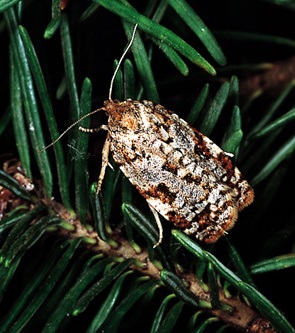Defoliators
Defoliating insects feed on the leaves or needles from trees. They can be beneficial or harmful to the health and productivity of forests. Integral to all forest ecosystems, defoliators feed on coniferous and deciduous hosts.
These insects are significant forest pests in forests across Canada. In B.C., several major defoliator species concern forest managers.
On this page
Effects of defoliation
Depending on the duration and the severity of insect defoliation, tree growth may be stunted. Top-kill and eventual tree mortality can result. Feeding is often most severe on understory or suppressed trees, so defoliating insects may serve as natural thinning agents. In some ecosystems, maintaining understory is vital to maintain a continuous crop of trees.
Tree mortality due to defoliator feeding can contribute to forest succession. Meanwhile, harvesting, regeneration, and stand-management activities can affect the interactive competition, population fluctuations, and spread of defoliator populations.
Another aspect of defoliation is nutrient cycling in the form of dead insects, insect frass, and foliage dropped to the ground from wasteful feeding. Damage due to defoliation may have significant effects upon:
- The continuous availability of timber
- Aesthetics in parks and recreational areas
- Property values where standing live trees are integral components of the property
- Watershed and wildlife values
- Human health
Managing outbreaks
Early detection and identification of an outbreak, and identification of the causal insect, are critical initial steps in managing forest defoliators. Projected damage may be severe enough to warrant treatments, either directly through application of suitable insecticides, or indirectly through harvesting or silviculture treatments.
Be sure to consider potential defoliator outbreaks throughout all phases of forest management. Defoliators should be considered at all levels of planning and when creating prescriptions, even though they may not be treated in all situations.
Actively managed defoliators in B.C.
Western spruce budworm (WSBW or IDW)
The western spruce budworm is an important native defoliator of Interior Douglas-fir. Periodically, population levels reach outbreak proportions. In 1987, more than 800,000ha were under attack. Aerial spray programs have been conducted to reduce defoliation. Learn more about the western spruce budworm.
Douglas-fir tussock moth (DFTM or IDT)
The Douglas-fir tussock moth is a destructive native defoliator of Douglas-fir. Outbreaks of tussock moth occur every 10 to 12 years, causing significant damage and mortality to stands in B.C.'s Interior. The hairs on the caterpillars can threaten the health of humans and domestic animals. Learn more about the Douglas-fir tussock moth.
Western hemlock looper (WHL or IDL)
The western hemlock looper is a native defoliator of western hemlock, western redcedar, Douglas-fir and Interior spruce. This insect periodically reaches outbreak levels, causing severe damage. Learn more about the western hemlock looper
Other defoliators in B.C.
Black army cutworm
Black army cutworm was a major pest in the 1980s when prescribed burning was used for site preparation. Once prescribed burning stopped the impacts of the black army cutworm became less severe as black army cutworm feeds on a range of plants and conifer seedlings growing on recently burned sites. Learn more about black army cutworms.
Blackheaded budworm
The blackheaded budworm is one of the most destructive defoliators in coastal B.C. Trees can be completely defoliated by a heavy attack, and severe defoliation can result in growth reduction and susceptibility to other biotic or abiotic forest health factors. Learn more about blackheaded budworms.
Balsam woolly adelgid (invasive)
This tiny, wingless, aphid-like insect infests and kills or severely damages true firs in south coastal B.C. So far its range is limited but it is expected to expand to more areas throughout B.C. Learn more about the balsam woolly adelgid.
Conifer sawfly
Tree mortality is uncommon unless repeated defoliations occur or if a conifer sawfly infestation occurs at the same time as that of another defoliator that prefers new foliage. Learn more about the conifer sawfly.
Eastern spruce budworm
The eastern spruce budworm is a moth often called the spruce budworm outside of British Columbia. It's a major defoliator in boreal forests in eastern Canada. The spruce budworm has been associated with the term "Spruce Decline Syndrome". Learn more about the eastern spruce budworm.
Larch sawfly
Larch sawfly outbreaks may occur over thousands of hectacres in British Columbia but cause little tree mortality due to defoliation. Learn more about the larch sawfly.
Satin moth
Adults are large, silvery white moths. Larvae are 3.5 to 4.5 cm long and are a medium grey / brown with a double row of shiny yellowish blotches. The satin moth is found on Vancouver Island, the Fraser Valley and throughout southern and central British Columbia. Learn more about the satin moth.
Two-year cycle budworm
Two-year cycle budworm is found primarily in central and northeast British Columbia. This budworm is distinguished by noticeable defoliation every second year, corresponding to the two-year life cycle. Learn more about the two-year cycle budworm.
Southern interior spray program

The western spruce budworm is the most destructive defoliator of coniferous forests in western North America.
